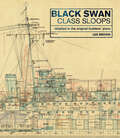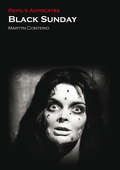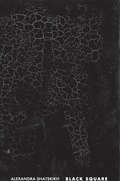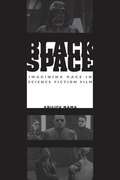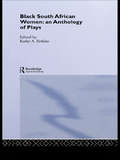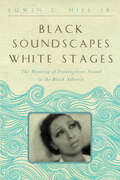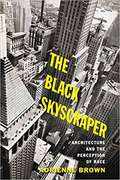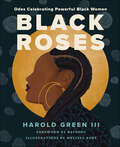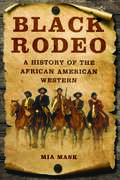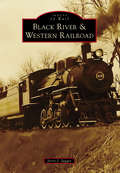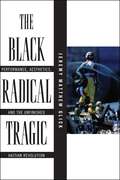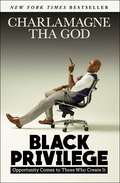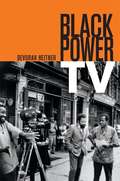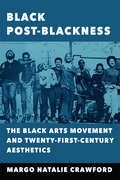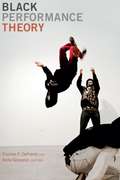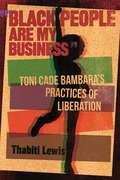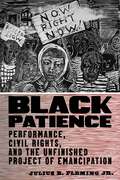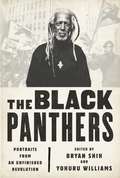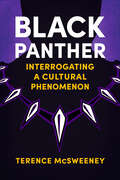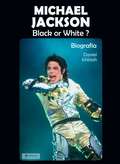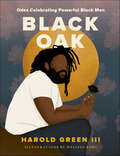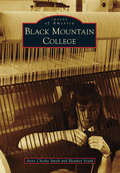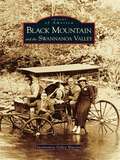- Table View
- List View
Black Swan Class Sloops: Detailed in the Original Builders' Plans
by Les BrownAn illustrated reference featuring the superbly drawn plans for these highly effective anti-submarine ships. The technical details of British warships were recorded in a set of plans produced by the builders on completion of every ship. Known as the &“as fitted&” general arrangements, these drawings represented the exact appearance and fitting of the ship as it entered service. Intended to provide a permanent reference for the Admiralty and the dockyards, these plans were drawn with exquisite skill in multi-colored inks and washes that represent the acme of the draftsman&’s art. Today they form part of the collection of the National Maritime Museum at Greenwich, which is using the latest scanning technology to make digital copies of the highest quality. This book is one of a series based entirely on these drafts, depicting famous warships in unprecedented detail—complete sets in full color, with many close-ups and enlargements that make every aspect clear. Captions point the reader to important features, and an introduction covers the background to the design. This volume is devoted to the sloops of the Black Swan class and its improved derivatives, widely regarded as the &“Rolls-Royce&” of Second World War convoy escorts. Heavily armed and superbly equipped for their role, they were among the most effective anti-submarine ships of the battle in the Atlantic. The design was gradually improved and this book uses plans of four selected ships to chart that development. These comprise: Black Swan as built; Flamingo as modified later; Starling, the single most successful U-boat hunter of the war, as in 1943; and Amethyst, as refitted after her clash with Chinese communists on the Yangtze in 1949.
Black Sunday (Devil's Advocates)
by Martyn ConterioConsiders the particularly Italian perspective on the gothic and a fresh and pioneering approach to horror tropes
Black Square
by Ms Marian Schwartz Aleksandra ShatskikhKazimir Malevich's painting Black Square is one of the twentieth century's emblematic paintings, the visual manifestation of a new period in world artistic culture at its inception. None of Malevich's contemporary revolutionaries created a manifesto, an emblem, as capacious and in its own way unique as this work; it became both the quintessence of the Russian avant-gardist's own art--which he called Suprematism--and a milestone on the highway of world art. Writing about this single painting, Aleksandra Shatskikh sheds new light on Malevich, the Suprematist movement, and the Russian avant-garde.Malevich devoted his entire life to explicating Black Square's meanings. This process engendered a great legacy: the original abstract movement in painting and its theoretical grounding; philosophical treatises; architectural models; new art pedagogy; innovative approaches to theater, music, and poetry; and the creation of a new visual environment through the introduction of decorative applied designs. All of this together spoke to the tremendous potential for innovative shape and thought formation concentrated in Black Square.To this day, many circumstances and events of the origins of Suprematism have remained obscure and have sprouted arbitrary interpretations and fictions. Close study of archival materials and testimonies of contemporaries synchronous to the events described has allowed this author to establish the true genesis of Suprematism and its principal painting.
Black Space
by Adilifu NamaScience fiction film offers its viewers many pleasures, not least of which is the possibility of imagining other worlds in which very different forms of society exist. Not surprisingly, however, these alternative worlds often become spaces in which filmmakers and film audiences can explore issues of concern in our own society. Through an analysis of over thirty canonic science fiction (SF) films, including Logan's Run, Star Wars, Blade Runner, Back to the Future, Gattaca, and Minority Report, Black Space offers a thorough-going investigation of how SF film since the 1950s has dealt with the issue of race and specifically with the representation of blackness. Setting his study against the backdrop of America's ongoing racial struggles and complex socioeconomic histories, Adilifu Nama pursues a number of themes in Black Space. They include the structured absence/token presence of blacks in SF film; racial contamination and racial paranoia; the traumatized black body as the ultimate signifier of difference, alienness, and "otherness"; the use of class and economic issues to subsume race as an issue; the racially subversive pleasures and allegories encoded in some mainstream SF films; and the ways in which independent and extra-filmic productions are subverting the SF genre of Hollywood filmmaking. The first book-length study of African American representation in science fiction film, Black Space demonstrates that SF cinema has become an important field of racial analysis, a site where definitions of race can be contested and post-civil rights race relations (re)imagined.
Black South African Women: An Anthology of Plays
by Kathy A. PerkinsThis is the first anthology to focus exclusively on the lives of Black South African women. This collection represents the work of both female and male writers, including national and international award-winning playwrights. The collection includes six full-length and four one-act plays, as well as interviews with the writers, who candidly discuss the theatrical and political situation in the new South Africa. Written before and after apartheid, the plays present varying approaches and theatrical styles from solo performances to collective creations. The plays dramatise issues as diverse as: * women's rights * displacement from home * violence against women * the struggle to keep families together * racial identity * education in the old and new South Africa * and health care.
Black Soundscapes White Stages: The Meaning of Francophone Sound in the Black Atlantic (The <I>Callaloo</I> African Diaspora Series)
by Edwin C. Hill Jr.An innovative look at the dynamic role of sound in the culture of the African Diaspora as found in poetry, film, travel narratives, and popular music.Black Soundscapes White Stages explores the role of sound in understanding the African Diaspora on both sides of the Atlantic, from the City of Light to the islands of the French Antilles. From the writings of European travelers in the seventeenth century to short-wave radio transmissions in the early twentieth century, Edwin C. Hill Jr. uses music, folk song, film, and poetry to listen for the tragic cri nègre. Building a conceptualization of black Atlantic sound inspired by Frantz Fanon's pioneering work on colonial speech and desire, Hill contends that sound constitutes a terrain of contestation, both violent and pleasurable, where colonial and anti-colonial ideas about race and gender are critically imagined, inscribed, explored, and resisted. In the process, this book explores the dreams and realizations of black diasporic mobility and separation as represented by some of its most powerful soundtexts and cultural practitioners, and it poses questions about their legacies for us today.In the process, thee dreams and realities of Black Atlantic mobility and separation as represented by some of its most powerful soundtexts and cultural practitioners, such as the poetry of Léon-Gontran Damas—a founder of the Négritude movement—and Josephine Baker’s performance in the 1935 film Princesse Tam Tam. As the first in Johns Hopkins’s new series on the African Diaspora, this book offers new insight into the legacies of these exceptional artists and their global influence.
The Black Skyscraper: Architecture And The Perception Of Race
by Adrienne BrownWith the development of the first skyscrapers in the 1880s, urban built environments could expand vertically as well as horizontally. Tall buildings emerged in growing cities to house and manage the large and racially diverse populations of migrants and immigrants flocking to their centers following Reconstruction. Beginning with Chicago's early 10-story towers and concluding with the 1931 erection of the 102-story Empire State Building, Adrienne Brown's The Black Skyscraper provides a detailed account of how scale and proximity shape our understanding of race. Over the next half-century, as city skylines grew, American writers imagined the new urban backdrop as an obstacle to racial differentiation. Examining works produced by writers, painters, architects, and laborers who grappled with the early skyscraper's outsized and disorienting dimensions, Brown explores this architecture's effects on how race was seen, read, and sensed at the turn of the twentieth century. In lesser-known works of apocalyptic science fiction, light romance, and Jazz Age melodrama, as well as in more canonical works by W. E. B. Du Bois, F. Scott Fitzgerald, Aaron Douglas, and Nella Larsen, the skyscraper mediates the process of seeing and being seen as a racialized subject. From its distancing apex—reducing bodies to specks—to the shadowy mega-blocks it formed at street level, the skyscraper called attention, Brown argues, to the malleable nature of perception. A highly interdisciplinary work, The Black Skyscraper reclaims the influence of race on modern architectural design as well as the less-well-understood effects these designs had on the experience and perception of race.
Black Roses: Odes Celebrating Powerful Black Women
by Harold GreenThe poet and founder of the music collective Flowers for the Living pays tribute to all Black women by focusing on visionaries and leaders who are making history right now, including Ava DuVernay, Janelle Monae, Kamala Harris, Misty Copeland, Nikole Hannah-Jones, Robin Roberts, Roxane Gay, and Simone Biles—with this compilation of celebratory odes featuring full-color illustrations by Melissa Koby.Black women are exceptional. To honor how Black women use their minds, talent, passion, and power to transform society, Harold Green began writing love letters in verse which he shared on his Instagram account. Balm for our troubled times, his tributes to visionaries and leaders quickly went viral and became a social media sensation. Now, in this remarkable collection, Green brings together many of these popular odes with never-before-seen works. A timely celebration of contemporary Black figures who are making history and shaping our culture today, Black Roses is divided into five sections—advocates, curators, innovators, luminaries, trailblazers—reflecting the diversity of Black women’s achievements and the depth of their reach. These inspiring changemakers are leaving their mark on the world by creating new beauty in their respective art forms, heading movements, fighting for equality and to change the status quo, and championing new definitions of what’s possible in every meaningful way. Green lifts them up to create meaningful connections between these figures and our own lives and experiences.Black Roses spotlights and urges readers to learn more about Allyson Felix, Angelica Ross, Ava DuVernay, Bisa Butler, Bozoma Saint John, Charisma Sweat-Green, Dr. Eve Ewing, Dr. Janice Jackson, Dr. Johnnetta Cole, Eunique Jones-Gibson, Issa Rae, Janelle Monae, Jennifer Hudson, Jessica Matthews, Kamala Harris, Keisha Bottoms, Kimberly Bryant, Kimberly Drew, Lisa Green, Lizzo, Mandilyn Graham, Mellody Hobson, Michelle Alexander, Misty Copeland, Naomi Beckwith, Nikole Hannah-Jones, Phylicia Rashad, Rapsody, Raquel Willis, Robin Roberts, Roxane Gay, Shellye Archambeau, Simone Biles, Stacey Abrams, Tabitha Brown, Tamika Mallory, Tarana Burke, Tasha Bell, Tomi Adeyemi, and Tracee Ellis Ross.
Black Rodeo: A History of the African American Western
by Mia MaskAfrican American westerns have a rich cinematic history and visual culture. Mia Mask examines the African American western hero within the larger context of film history by considering how Black westerns evolved and approached wide-ranging goals. Woody Strode’s 1950s transformation from football star to actor was the harbinger of hard-edged western heroes later played by Jim Brown and Fred Williamson. Sidney Poitier’s Buck and the Preacher provided a narrative helmed by a groundbreaking African American director and offered unconventionally rich roles for women. Mask moves from these discussions to consider blaxploitation westerns and an analysis of Jeff Kanew’s hard-to-find 1972 documentary about an all-Black rodeo. The book addresses how these movies set the stage for modern-day westploitation films like Django Unchained. A first-of-its kind survey, Black Rodeo illuminates the figure of the Black cowboy while examining the intersection of African American film history and the western.
Black River & Western Railroad (Images of Rail)
by Jerry J. JaggerThe Black River & Western Railroad has provided over 50 continuous years of passenger excursions in rural New Jersey between Flemington and Ringoes, passing through the pristine scenery of Hunterdon County. May 16, 1965, was the first official day of steam-powered passenger excursions, and 50 years later, on May 16, 2015, the same steam locomotive provided power for another steam-powered excursion. During those years, the railroad has grown from the simple excursion attraction of historic railroad equipment, providing the public amusement, to a regional short-line railroad.
Black River Canal (Images of America)
by Edward P. Fynmore Harney J. CorwinBlack River Canal documents in images how a manmade river transformed a region. This upper New York State canal was an improbable engineering success. In 1825, DeWitt Clinton proposed construction of a canal that would link the Erie Canal at Rome with the Black River at Lyons Falls. The idea was well received, but the obstacles were great. The canal would have to run uphill. In the end, the 35-mile overland canal required a record 109 locks to negotiate a rise and fall of 1,079 feet. Construction was authorized in 1836, and against all odds, the Black River Canal was fully operational in 1855. The canal brought a measure of prosperity to an isolated region of the state and promoted development of a wood products industry that continues to this day.
The Black Radical Tragic: Performance, Aesthetics, and the Unfinished Haitian Revolution (America and the Long 19th Century #2)
by Jeremy Matthew GlickAs the first successful revolution emanating from a slave rebellion, the Haitian Revolution remains an inspired site of investigation for a remarkable range of artists and activist-intellectuals in the African Diaspora. In The Black Radical Tragic, Jeremy Matthew Glick examines twentieth-century performances engaging the revolution as laboratories for political thinking. Asking readers to consider the revolution less a fixed event than an ongoing and open-ended history resonating across the work of Atlantic world intellectuals, Glick argues that these writers use the Haitian Revolution as a watershed to chart their own radical political paths, animating, enriching, and framing their artistic and scholarly projects. Spanning the disciplines of literature, philosophy, and political thought, The Black Radical Tragic explores work from Lorraine Hansberry, Sergei Eisenstein, Edouard Glissant, Malcolm X, and others, ultimately enacting a speculative encounter between Bertolt Brecht and C.L.R. James to reconsider the relationship between tragedy and revolution. In its grand refusal to forget, The Black Radical Tragic demonstrates how the Haitian Revolution has influenced the ideas of freedom and self-determination that have propelled Black radical struggles throughout the modern era.
Black Privilege: Opportunity Comes to Those Who Create It
by Charlamagne Tha God<P>Charlamagne Tha God—the self-proclaimed “Prince of Pissing People Off,” co-host of Power 105.1’s The Breakfast Club, and “hip-hop’s Howard Stern”—shares his unlikely success story as well as how embracing one’s truths is a fundamental key to success and happiness. <P>In his new book, Charlamagne Tha God presents his comic, often controversial, and always brutally honest insights on how living an authentic life is the quickest path to success. Beginning with his journey from the small town of Moncks Corner, South Carolina to his headline grabbing interviews with celebrities like Justin Bieber, Jay-Z, Nicki Minaj, Kanye West, and Hillary Clinton, he shares how he turned his troubled early life around by owning his (many) mistakes and refusing to give up on his dreams, even after his controversial opinions got him fired from several on-air jobs. <P>Combining his own story with bold advice and his signature commitment to honesty at all costs, Charlamagne hopes this book will give others the confidence to live their own truths. <P><b>A New York Times Bestseller</b>
Black Power TV
by Devorah HeitnerIn Black Power TV, Devorah Heitner chronicles the emergence of Black public affairs television starting in 1968. She examines two local shows, New York's Inside Bedford-Stuyvesant and Boston's Say Brother, and the national programs Soul! and Black Journal. These shows offered viewers radical and innovative programming: the introspections of a Black police officer in Harlem, African American high school students discussing visionary alternatives to the curriculum, and Miriam Makeba comparing race relations in the United States to apartheid in South Africa. While Inside Bedford-Stuyvesant and Say Brother originated from a desire to contain Black discontent during a period of urban uprisings and racial conflict, these shows were re-envisioned by their African American producers as venues for expressing Black critiques of mainstream discourse, disseminating Black culture, and modeling Black empowerment. At the national level, Soul! and Black Journal allowed for the imagining of a Black nation and a distinctly African American consciousness, and they played an influential role in the rise of the Black Arts Movement. Black Power TV reveals how regulatory, activist, and textual histories are interconnected and how Black public affairs television redefined African American representations in ways that continue to reverberate today.
Black Post-Blackness: The Black Arts Movement and Twenty-First-Century Aesthetics
by Margo Natalie CrawfordA 2008 cover of The New Yorker featured a much-discussed Black Power parody of Michelle and Barack Obama. The image put a spotlight on how easy it is to flatten the Black Power movement as we imagine new types of blackness. Margo Natalie Crawford argues that we have misread the Black Arts Movement's call for blackness. We have failed to see the movement's anticipation of the "new black" and "post-black." Black Post-Blackness compares the black avant-garde of the 1960s and 1970s Black Arts Movement with the most innovative spins of twenty-first century black aesthetics. Crawford zooms in on the 1970s second wave of the Black Arts Movement and shows the connections between this final wave of the Black Arts movement and the early years of twenty-first century black aesthetics. She uncovers the circle of black post-blackness that pivots on the power of anticipation, abstraction, mixed media, the global South, satire, public interiority, and the fantastic.
Black Performance Theory
by Anita Gonzalez Thomas F. DefrantzBlack performance theory is a rich interdisciplinary area of study and critical method. This collection of new essays by some of its pioneering thinkers--many of whom are performers--demonstrates the breadth, depth, innovation, and critical value of black performance theory. Considering how blackness is imagined in and through performance, the contributors address topics including flight as a persistent theme in African American aesthetics, the circulation of minstrel tropes in Liverpool and in Afro-Mexican settlements in Oaxaca, and the reach of hip-hop politics as people around the world embrace the music and dance. They examine the work of contemporary choreographers Ronald K. Brown and Reggie Wilson, the ways that African American playwrights translated the theatricality of lynching to the stage, the ecstatic music of Little Richard, and Michael Jackson's performance in the documentary This Is It. The collection includes several essays that exemplify the performative capacity of writing, as well as discussion of a project that re-creates seminal hip-hop album covers through tableaux vivants. Whether deliberating on the tragic mulatta, the trickster figure Anansi, or the sonic futurism of Nina Simone and Adrienne Kennedy, the essays in this collection signal the vast untapped critical and creative resources of black performance theory.Contributors. Melissa Blanco Borelli, Daphne A. Brooks, Soyica Diggs Colbert, Thomas F. DeFrantz, Nadine George-Graves, Anita Gonzalez, Rickerby Hinds, Jason King, D. Soyini Madison, Koritha Mitchell, Tavia Nyong'o, Carl Paris, Anna B. Scott, Wendy S. Walters, Hershini Bhana Young
"Black People Are My Business": Toni Cade Bambara's Practices of Liberation (African American Life Series)
by Thabiti Lewis"Black People Are My Business": Toni Cade Bambara’s Practices of Liberation studies the works of Bambara (1939–1995), an author, documentary filmmaker, social activist, and professor. Thabiti Lewis’s analysis serves as a cultural biography, examining the liberation impulses in Bambara’s writing, which is concerned with practices that advance the material value of the African American experience and exploring the introspection between artist production and social justice. This is the first monograph that focuses on Bambara’s unique approach and important literary contribution to 1970s and 1980s African American literature. It explores her unique nationalist, feminist, Marxist, and spiritualist ethos, which cleared space for many innovations found in black women’s fiction. Divided into five chapters, Lewis’s study relies on Bambara’s voice (from interviews and essays) to craft a "spiritual wholeness aesthetic"—a set of principles that comes out of her practices of liberation and entail family, faith, feeling, and freedom—that reveals her ability to interweave ethnic identity, politics, and community engagement and responsibility with the impetus of balancing black male and female identity influences and interactions within and outside the community. One key feature of Bambara’s work is the concentration on women as cultural workers whereby her notion of spiritual wholeness upends what has become a scholarly distinction between feminism and black nationalism. Bambara’s fiction situates her as a pivotal voice within the Black Arts Movement and contemporary African American literature. Bambara is an understudied and important artistic voice whose aversion to playing it safe both personified and challenged the boundaries of black nationalism and feminism. "Black People Are My Business" is a wonderful addition to any reader’s list, especially those interested in African American literary and cultural studies.
Black Patience: Performance, Civil Rights, and the Unfinished Project of Emancipation (Performance and American Cultures)
by Julius B. Fleming Jr.A bold rethinking of the Civil Rights Movement through the lens of Black theater“Freedom, Now!” This rallying cry became the most iconic phrase of the Civil Rights Movement, challenging the persistent command that Black people wait—in the holds of slave ships and on auction blocks, in segregated bus stops and schoolyards—for their long-deferred liberation. In Black Patience, Julius B. Fleming Jr. argues that, during the Civil Rights Movement, Black artists and activists used theater to energize this radical refusal to wait. Participating in a vibrant culture of embodied political performance that ranged from marches and sit-ins to jail-ins and speeches, these artists turned to theater to unsettle a violent racial project that Fleming refers to as “Black patience.” Inviting the likes of James Baldwin, Lorraine Hansberry, Alice Childress, Douglas Turner Ward, Duke Ellington, and Oscar Brown Jr. to the stage, Black Patience illuminates how Black artists and activists of the Civil Rights era used theater to expose, critique, and repurpose structures of white supremacy. In this bold rethinking of the Civil Rights Movement, Fleming contends that Black theatrical performance was a vital technology of civil rights activism, and a crucial site of Black artistic and cultural production.
The Black Panthers: Portraits from an Unfinished Revolution (E-duke Books Scholarly Collection)
by Peniel E. Joseph Yohuru Williams Bryan Shih"Brilliant, painful, enlightening, tearful, tragic, sad, and funny, this photo-essay book is at its core about healing, and about the social justice work that still needs to be done in the era of hip-hop, Black Lives Matter, and the historic presidency of Barack Obama.” -Kevin Powell, author of The Education of Kevin Powell: A Boy's Journey into Manhood"A brilliantly conceived volume. Bryan Shih and Yohuru Williams demonstrate why the Panthers' story-its lessons and failures-even fifty years after its founding remains key to understanding national and international struggles for freedom and justice today.” -Cheryl Finley, professor and director of visual studies, Cornell UniversityEven fifty years after it was founded, the Black Panther Party remains one of the most misunderstood political organizations of the twentieth century. But beyond the labels of "extremist” and "violent” that have marked the party, and beyond charismatic leaders like Huey Newton, Bobby Seale, and Eldridge Cleaver, were the ordinary men and women who made up the Panther rank and file.In The Black Panthers, photojournalist Bryan Shih and historian Yohuru Williams offer a reappraisal of the party's history and legacy. Through stunning portraits and interviews with surviving Panthers, as well as illuminating essays by leading scholars, The Black Panthers reveals party members' grit and battle scars-and the undying love for the people that kept them going.
Black Panther: Interrogating a Cultural Phenomenon (Reframing Hollywood)
by Terence McSweeneyNamed a Nonfiction Book Awards Gold Winner by the Nonfiction Authors AssociationGold Winner of the 2022 eLit Book Award for Popular CultureWinner of a National Indie Excellence Award in the category of “Movies & TV”Book of the Year 2021 in African Studies awarded by CESTAFWinner of the 2022 Best Book Award in the category of “Performing Arts”Black Panther is one of the most financially successful and culturally impactful films to emerge from the American film industry in recent years. When it was released in 2018 it broke numerous records and resonated with audiences all around the world in ways that transcended the dimensions of the superhero film. In Black Panther: Interrogating a Cultural Phenomenon, author Terence McSweeney explores the film from a diverse range of perspectives, seeing it as not only a comic book adaptation and a superhero film, but also a dynamic contribution to the discourse of both African and African American studies. McSweeney argues that Black Panther is one of the defining American films of the last decade and the most remarkable title in the Marvel Cinematic Universe (2008–). The MCU has become the largest film franchise in the history of the medium and has even shaped the contours of the contemporary blockbuster, but the narratives within it have almost exclusively perpetuated largely unambiguous fantasies of American heroism and exceptionalism. In contrast, Black Panther complicates this by engaging in an entirely different mythos in its portrayal of an African nation—never colonized by Europe—as the most powerful and technologically advanced in the world. McSweeney charts how and why Black Panther became a cultural phenomenon and also a battleground on which a war of meaning was waged at a very particular time in American history.
Black or White: Biografia di Michael Jackson
by Daniel IchbiahFra tutte le star apparse durante diversi decenni, Michael Jackson resta la più affascinante, quella che sfugge di più all'analisi immediata. Pieno di talento, capace di mettere in scena spettacoli di rara qualità, di scrivere canzoni indimenticabili, di muovere il suo corpo in modo sbalorditivo, Michael Jackson ha sedotto il pubblico innanzitutto per le sue qualità artistiche. Come contropartita, il pubblico ha dovuto accettare le eccentricità fuori dal normale di un personaggio mai classificabile, una specie di eccentrico eroe di una favola che avrebbe deragliato lungo la strada. Resta il fatto che la Storia ricorderà l'essenziale : « Billy Jean », « Thriller », « Don’t stop til you get enough » e altre canzoni diventate dei classici e destinate a resistere all'usura del tempo… Come ha dichiarato un altro maestro della sua arte, Steven Spielberg : « Così come non avremo mai più altri Fred Astaire o altri Chuck Berry o altri Elvis Presley, non ci sarà mai più nessuno paragonabile a Michael Jackson. ». « Il suo talento, la sua vivacità e il suo lato misterioso fanno di lui una leggenda... ». Questo libro racconta la vita di Michael, si sofferma in modo approfondito sugli episodi più rilevanti della sua esistenza e descrive l'evoluzione del cantante. Parla del "dietro le quinte" di Thriller, l'album di tutti i records. Contiene anche dei ritratti di Quincy Jones, Janet Jackson e La Toya. Per quale motivo un genio della pop music si è trasformato in un personaggio enigmatico, alla ricerca di un'identità parallela?
Black Ops Bricks: How to Build Your Own Model Military and Armored Fighting Vehicles
by Nick GrantTwenty of the coolest vehicles ever dreamed up, ready to come to life brick by brick!Black Ops Bricks reconstructs the finest military and spy jets, trucks, and ships ever built. Inside you'll find step-by-step, full-color illustrations showing you how to create the best and most badass military and special operations vehicles ever made. From smaller projects to the eight-hundred-plus-piece hovercraft, the twenty projects included will keep you busy for weeks, putting your brick-building skills to the test as you race to complete and test-drive a variety of fighter jets, helicopters, and much more.These aren't wimpy diplay models that have to be handled with white gloves once assembled. These are fully usable models. All parts of the models are accessible and playable; there's never a cockpit you can't open. And the projects are constructed to be fully customizable; stopping points indicate breaks in a project where builders can choose to continue building with only their imaginations and ingenuity to guide them.As a useful tool, each building guide is fully annotated to show exactly which pieces are used in each step. Following along as these projects move their way toward the fully operational finished project is as easy as ever, and the majority of pieces needed to bring these projects to life are commonly available bricks, with piece substitutions offered to replace hard-to-find bricks.
Black Oak: Odes Celebrating Powerful Black Men
by Harold GreenAs he did for Black women in Black Roses, Harold Green III, poet and founder of the music collective Flowers for the Living, now honors the Black men he most admires—groundbreakers including Tyler Perry, Barry Jenkins, Billy Porter, Chance the Rapper, LeBron James, Colin Kaepernick, and John Legend—and celebrates their achievements which are transforming lives and making history.Black men are changing society and the world through mastery, innovation, and inspiration at a pace never seen before. In awe of the myriad ways in which Black men are using their vision and power to remake culture and society, spoken word artist Harold Green began writing odes recognizing the extraordinary accomplishments of a series of Black men, which heshared on his Instagram account—tributes that went viral and became a social media sensation. Black Oak brings together many of these popular odes with original works written for this collection.Divided into five sections—bravehearts, champions, dreamers, guardians, and humanitarians—Black Oak features iconic men who are spearheading movements, fighting for equality, challenging the status quo, embracing fatherhood, providing a transformative model of masculinity for our children, inspiring a new generation of creators, and more. Through these beautifully written verses, Harold does not simply place the Black men in this book on a pedestal, he transcends even the most positive stereotypes to view these men and their accomplishments in a new light, and creates meaningful connections between these beloved figures and the lives and experiences of readers of all backgrounds. Featuring full-color illustrations by Melissa Koby, Black Oak includes odes to Barry Jenkins, Big K.R.I.T, Billy Porter, Black Thought, Chance the Rapper, Charles Booker, Colin Kaepernick, Dwyane Wade, Edmund Graham III, Eric Hale, Excell Hardy Jr., Harold Green III, Harold Green Jr., Harold Green Sr., Hebru Brantley, Henry Louis Gates Jr., Jamaal Bowman, Jason Reynolds, Jericho Brown, John Legend, Kehinde Wiley, Kerry James Marshall, Kevin Fredricks, Killer Mike, Kyler Broadus, LeBron James, Mahershala Ali, Marc Lamont Hill, Matthew Cherry, Orlando Cooper, Pharrell, Rev. Dr. Otis Moss III, Rev. Dr. William Barber II, Ryan Coogler, Swizz Beatz, Ta-Nehisi Coates, Theaster Gates, Tobe Nwigwe, Tristan Walker, and Tyler Perry.
Black Mountain College
by Anne Chesky Smith Heather SouthLocated in the mountains of North Carolina, Black Mountain College was founded in 1933 by John Andrew Rice, Theodore Dreier, and other former faculty members from Rollins College. Their mission was to provide a liberal arts education that developed the student as a whole. Students and faculty lived and worked together on campus. Grades were abolished, and the arts were central to education. The college rented space for their first campus at Blue Ridge Assembly. In 1941, the college moved to the Lake Eden property they had purchased across the valley, allowing the school to grow. Many refugee artists found a home there, which provided an open and safe environment to create. Among the famous faculty and students of the college were Robert Rauschenberg, John Cage, Merce Cunningham, and Buckminster Fuller. Funding for the college was always scarce, and in debt, the college was finally forced to close its doors in 1957. Black Mountain College operated for only 24 years but left a lasting impact on the arts and education on an international scale.
Black Mountain and the Swannanoa Valley
by Swannanoa Valley MuseumNorth Carolina's magnificent Blue Ridge Mountains have drawn people to the Swannanoa Valley since the beginning of time. Rivers and forests lured early hunters and gatherers; later inhabitants tilled the rich, fertile soil and logged the thick forests on the mountainsides. People also came to the mountains to enjoy the mystical beauty and enchantment of the area, the cool, crisp climate, and the sparkling waters of brooks and streams. Hiking, camping, and the tranquility of a woodland world provided escape from city life. The Swannanoa Valley is cradled between the Craggy Mountains to the north and the Swannanoa Mountains to the south. Mount Mitchell, the highest peak in America east of the Mississippi River, rises majestically nearby. Among the early visitors who decided to settle in the valley were those who purchased the land that later became the sites of the famous conference centers in the area-Montreat, YMCA Blue Ridge Assembly, and Ridgecrest-and businessmen, who brought industry to the area.
